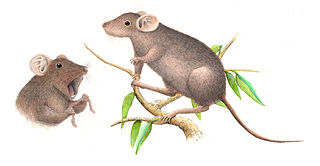
Parvoscincus is a genus of skinks, lizards in the family Scincidae. The genus is endemic to the Philippines.

Mount Banahaw is an active complex volcano on Luzon in the Philippines. The three-peaked volcano is located at the boundary of Laguna and Quezon provinces. It is the highest mountain in both provinces and Calabarzon region, dominating the landscape for miles around.

The large Mindoro forest mouse is a species of rodent in the family Muridae, from the genus Apomys. It is found only in the Philippines. Its natural habitat is subtropical or tropical moist montane forests. It is a large mouse with large feet, a long tail and an elongated snout which is morphologically unique within its genus. It is covered in soft fur which is mostly dark brown in colour. Its closest relative is thought to be the Luzon montane forest mouse, based on genetic and morphological similarities.

Dasia griffini, commonly known as Griffin's keel-scaled tree skink or Griffin's dasia, is a species of tree skink, a lizard in the family Scincidae. The species is endemic to central and northern Palawan and southern Mindoro in the Philippines.

Brachymeles bonitae, commonly known as the stub-limbed burrowing skink or pretty short-legged skink, is a species of skink found in the Philippines. It was first described in 1839 by André Marie Constant Duméril and Gabriel Bibron. It is endemic to the Philippines.

Parvoscincus leucospilos, the white-spotted sphenomorphus, is a species of skink endemic to the Philippines. It is found between 300 and 1,200 m above sea levels in the forests of central and southern Sierra Madre Mountain Range of Luzon Island. This skink hides under rocks or in debris in the banks of streams and rivers. When threatened by predators, such as snakes, it may dive and stay under water for a long time.

Otosaurus cumingii, commonly called Cuming's sphenomorphus or the Luzon giant forest skink, is a species of skink, a lizard in the family Scincidae. The species is endemic to the Philippines.
Nessia gansi, also known commonly as Gans's three-toed snake skink, is a species of lizard in the family Scincidae. The species is endemic to the island of Sri Lanka.

Tytthoscincus is a genus of skinks. Originally defined to include a few species from the Philippines, the genus now includes many species from South-East Asia in general.
Danilo S. Balete, also known as Danny Balete, was a Filipino zoologist and biologist. His is known for his work on the Philippines' endemic mammal species. He pursued the question of what determines species diversity. The research by Balete and his team overturned previously held notions that diversity decreased in mountainous regions, showing that harsh environments could generate, rather than suppress, species diversity.
Cryptoblepharus pannosus, also known commonly as the ragged snake-eyed skink, is a species of lizard in the family Scincidae. The species is endemic to Australia.

Eutropis cumingi, also known commonly as Cuming's eared skink, Cuming's mabouya, and Cuming's mabuya, is a species of lizard in the family Scincidae. The species is endemic to the Philippines.

Insulasaurus wrighti, also known commonly as Wright's sphenomorphus, is a species of skink, a lizard in the family Scincidae. The species is endemic to Palawan in the Philippines.
Parvoscincus beyeri, also known commonly as Beyer's sphenomorphus, is a species of skink, a lizard in the family Scincidae. The species is endemic to the Philippines.
Parvoscincus lawtoni is a species of lizard in the subfamily Sphenomorphinae of the family Scincidae (skinks). The species is endemic to the Philippines.
The Aurora mountain skink is a species of lizard in the family Scincidae. The species is endemic to the Philippines.

Jagor's sphenomorphus is a species of skink, a lizard in the family Scincidae. The species is endemic to the Philippines. There are two recognized subspecies.

Pinoyscincus llanosi, also known commonly as the Leyte sphenomorphus, is a species of skink, a lizard in the family Scincidae. The species is endemic to the Philippines.
The Mindanao sphenomorphus is a species of skink, a lizard in the family Scincidae. The species is endemic to the Philippines.

Brachymeles boulengeri, Boulenger's short-legged skink, is a species of lizard in the family Scincidae. The species is endemic to the Philippines.













